CHCCSL006 & CHCCSL007 Counselling Therapies and Support: Diploma
VerifiedAdded on 2023/06/07
|21
|5526
|322
Homework Assignment
AI Summary
This assignment delves into various aspects of counseling therapies, beginning with a personal experience of catastrophizing and its management through validity testing. It outlines a treatment plan for passive-aggressiveness, including background, goals, and strategies. The assignment further discusses Acceptance and Commitment Therapy (ACT) as a treatment for anxiety, highlighting its principles and benefits. A metaphorical representation of a troubling personal aspect is presented, followed by a detailed explanation of ACT, its origins, principles, and limitations. The document also explores the integration of multiple therapeutic techniques for complex cases and applies specific therapies to address anxiety, self-esteem, and social isolation. Finally, it analyzes a case study of an individual facing emotional issues like fear, anxiety, and low self-esteem, emphasizing the need for tailored interventions. This assignment showcases a comprehensive understanding of counseling therapies and their practical applications.
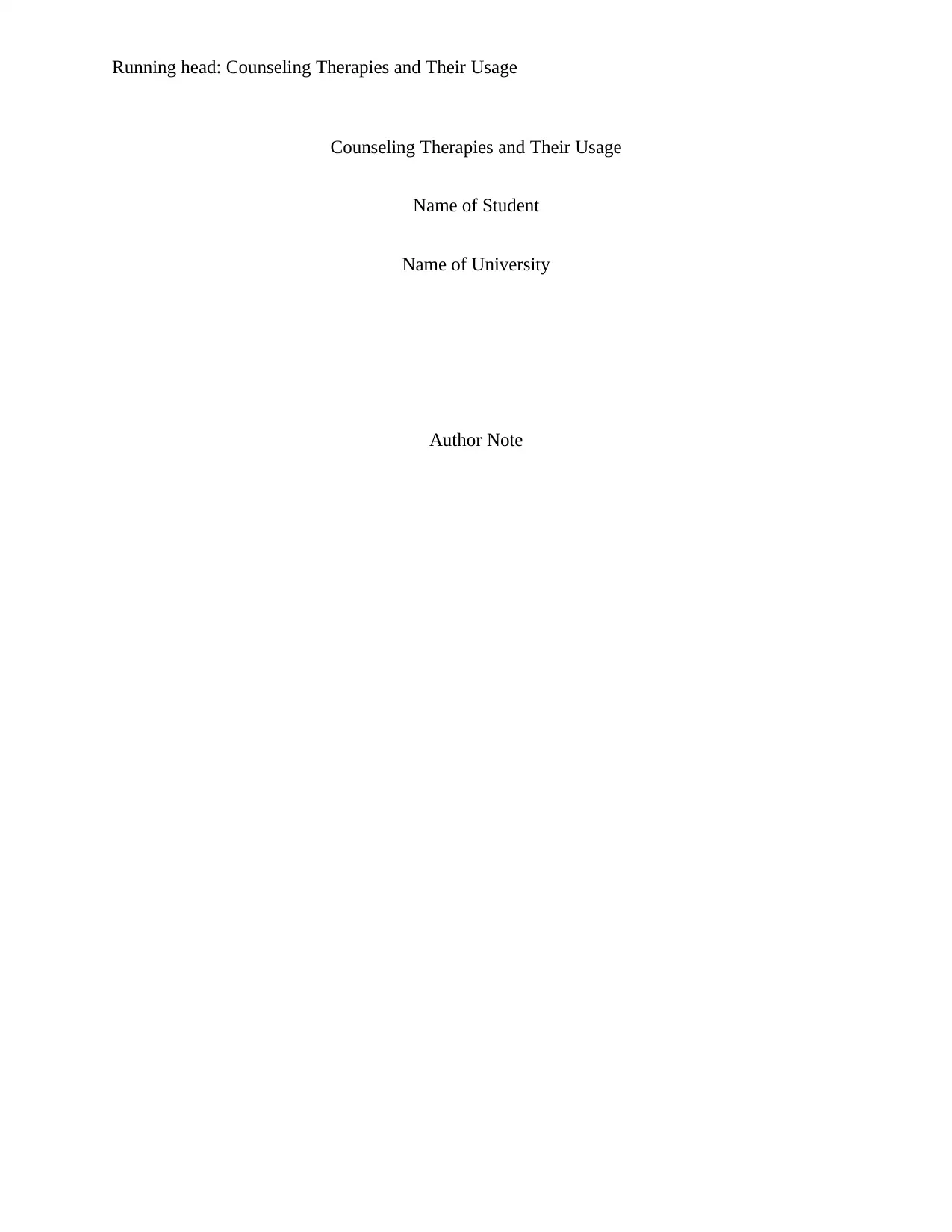
Running head: Counseling Therapies and Their Usage
Counseling Therapies and Their Usage
Name of Student
Name of University
Author Note
Counseling Therapies and Their Usage
Name of Student
Name of University
Author Note
Paraphrase This Document
Need a fresh take? Get an instant paraphrase of this document with our AI Paraphraser
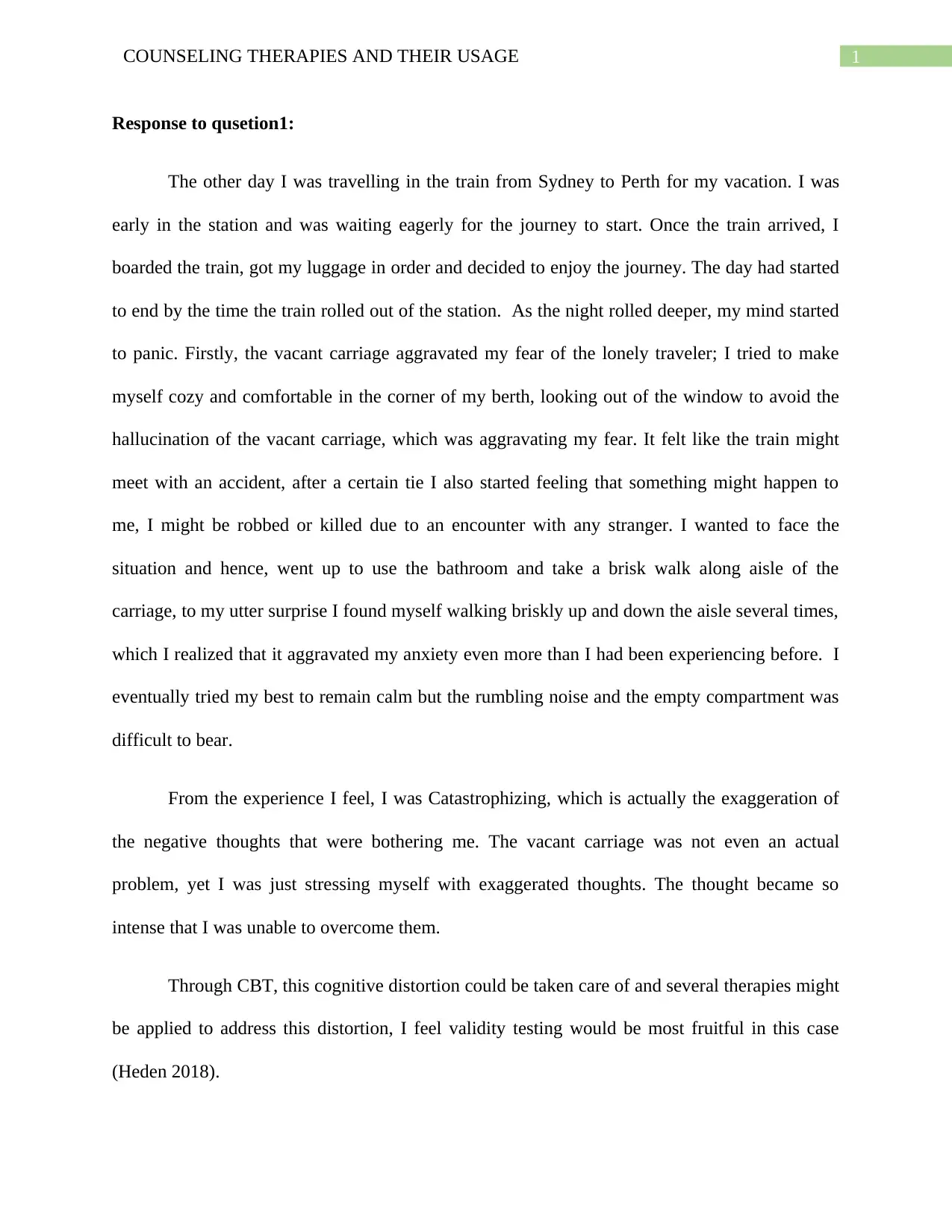
1COUNSELING THERAPIES AND THEIR USAGE
Response to qusetion1:
The other day I was travelling in the train from Sydney to Perth for my vacation. I was
early in the station and was waiting eagerly for the journey to start. Once the train arrived, I
boarded the train, got my luggage in order and decided to enjoy the journey. The day had started
to end by the time the train rolled out of the station. As the night rolled deeper, my mind started
to panic. Firstly, the vacant carriage aggravated my fear of the lonely traveler; I tried to make
myself cozy and comfortable in the corner of my berth, looking out of the window to avoid the
hallucination of the vacant carriage, which was aggravating my fear. It felt like the train might
meet with an accident, after a certain tie I also started feeling that something might happen to
me, I might be robbed or killed due to an encounter with any stranger. I wanted to face the
situation and hence, went up to use the bathroom and take a brisk walk along aisle of the
carriage, to my utter surprise I found myself walking briskly up and down the aisle several times,
which I realized that it aggravated my anxiety even more than I had been experiencing before. I
eventually tried my best to remain calm but the rumbling noise and the empty compartment was
difficult to bear.
From the experience I feel, I was Catastrophizing, which is actually the exaggeration of
the negative thoughts that were bothering me. The vacant carriage was not even an actual
problem, yet I was just stressing myself with exaggerated thoughts. The thought became so
intense that I was unable to overcome them.
Through CBT, this cognitive distortion could be taken care of and several therapies might
be applied to address this distortion, I feel validity testing would be most fruitful in this case
(Heden 2018).
Response to qusetion1:
The other day I was travelling in the train from Sydney to Perth for my vacation. I was
early in the station and was waiting eagerly for the journey to start. Once the train arrived, I
boarded the train, got my luggage in order and decided to enjoy the journey. The day had started
to end by the time the train rolled out of the station. As the night rolled deeper, my mind started
to panic. Firstly, the vacant carriage aggravated my fear of the lonely traveler; I tried to make
myself cozy and comfortable in the corner of my berth, looking out of the window to avoid the
hallucination of the vacant carriage, which was aggravating my fear. It felt like the train might
meet with an accident, after a certain tie I also started feeling that something might happen to
me, I might be robbed or killed due to an encounter with any stranger. I wanted to face the
situation and hence, went up to use the bathroom and take a brisk walk along aisle of the
carriage, to my utter surprise I found myself walking briskly up and down the aisle several times,
which I realized that it aggravated my anxiety even more than I had been experiencing before. I
eventually tried my best to remain calm but the rumbling noise and the empty compartment was
difficult to bear.
From the experience I feel, I was Catastrophizing, which is actually the exaggeration of
the negative thoughts that were bothering me. The vacant carriage was not even an actual
problem, yet I was just stressing myself with exaggerated thoughts. The thought became so
intense that I was unable to overcome them.
Through CBT, this cognitive distortion could be taken care of and several therapies might
be applied to address this distortion, I feel validity testing would be most fruitful in this case
(Heden 2018).
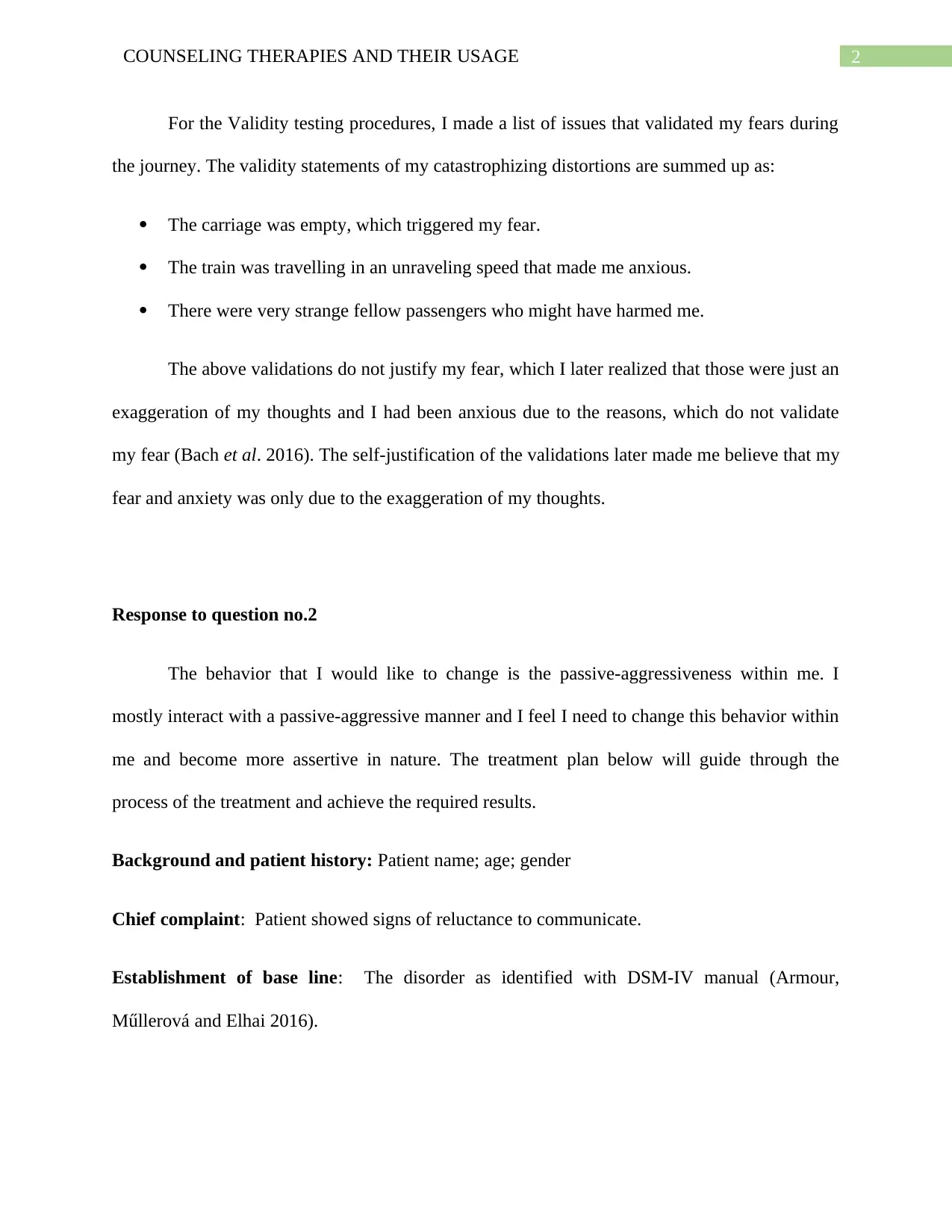
2COUNSELING THERAPIES AND THEIR USAGE
For the Validity testing procedures, I made a list of issues that validated my fears during
the journey. The validity statements of my catastrophizing distortions are summed up as:
The carriage was empty, which triggered my fear.
The train was travelling in an unraveling speed that made me anxious.
There were very strange fellow passengers who might have harmed me.
The above validations do not justify my fear, which I later realized that those were just an
exaggeration of my thoughts and I had been anxious due to the reasons, which do not validate
my fear (Bach et al. 2016). The self-justification of the validations later made me believe that my
fear and anxiety was only due to the exaggeration of my thoughts.
Response to question no.2
The behavior that I would like to change is the passive-aggressiveness within me. I
mostly interact with a passive-aggressive manner and I feel I need to change this behavior within
me and become more assertive in nature. The treatment plan below will guide through the
process of the treatment and achieve the required results.
Background and patient history: Patient name; age; gender
Chief complaint: Patient showed signs of reluctance to communicate.
Establishment of base line: The disorder as identified with DSM-IV manual (Armour,
Műllerová and Elhai 2016).
For the Validity testing procedures, I made a list of issues that validated my fears during
the journey. The validity statements of my catastrophizing distortions are summed up as:
The carriage was empty, which triggered my fear.
The train was travelling in an unraveling speed that made me anxious.
There were very strange fellow passengers who might have harmed me.
The above validations do not justify my fear, which I later realized that those were just an
exaggeration of my thoughts and I had been anxious due to the reasons, which do not validate
my fear (Bach et al. 2016). The self-justification of the validations later made me believe that my
fear and anxiety was only due to the exaggeration of my thoughts.
Response to question no.2
The behavior that I would like to change is the passive-aggressiveness within me. I
mostly interact with a passive-aggressive manner and I feel I need to change this behavior within
me and become more assertive in nature. The treatment plan below will guide through the
process of the treatment and achieve the required results.
Background and patient history: Patient name; age; gender
Chief complaint: Patient showed signs of reluctance to communicate.
Establishment of base line: The disorder as identified with DSM-IV manual (Armour,
Műllerová and Elhai 2016).
⊘ This is a preview!⊘
Do you want full access?
Subscribe today to unlock all pages.

Trusted by 1+ million students worldwide
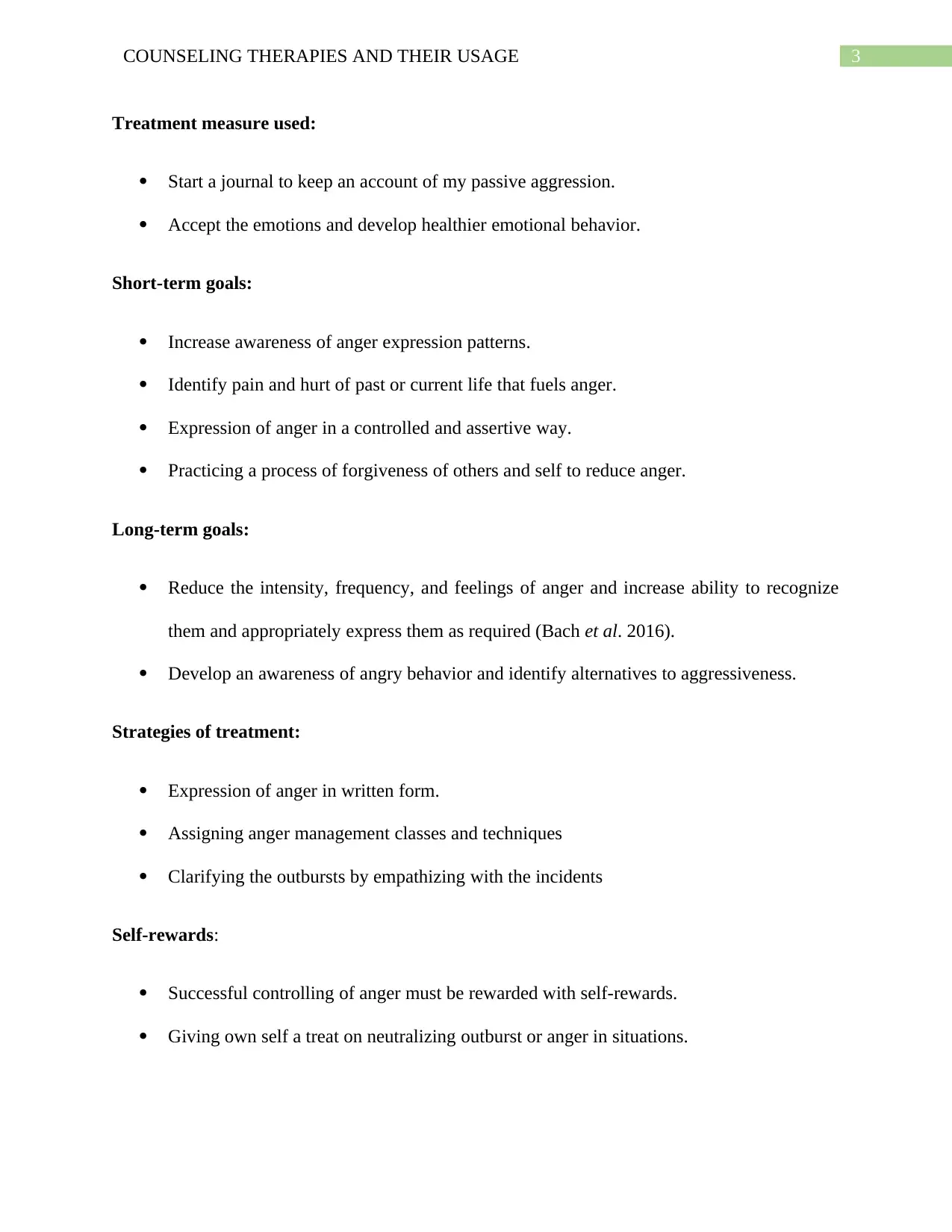
3COUNSELING THERAPIES AND THEIR USAGE
Treatment measure used:
Start a journal to keep an account of my passive aggression.
Accept the emotions and develop healthier emotional behavior.
Short-term goals:
Increase awareness of anger expression patterns.
Identify pain and hurt of past or current life that fuels anger.
Expression of anger in a controlled and assertive way.
Practicing a process of forgiveness of others and self to reduce anger.
Long-term goals:
Reduce the intensity, frequency, and feelings of anger and increase ability to recognize
them and appropriately express them as required (Bach et al. 2016).
Develop an awareness of angry behavior and identify alternatives to aggressiveness.
Strategies of treatment:
Expression of anger in written form.
Assigning anger management classes and techniques
Clarifying the outbursts by empathizing with the incidents
Self-rewards:
Successful controlling of anger must be rewarded with self-rewards.
Giving own self a treat on neutralizing outburst or anger in situations.
Treatment measure used:
Start a journal to keep an account of my passive aggression.
Accept the emotions and develop healthier emotional behavior.
Short-term goals:
Increase awareness of anger expression patterns.
Identify pain and hurt of past or current life that fuels anger.
Expression of anger in a controlled and assertive way.
Practicing a process of forgiveness of others and self to reduce anger.
Long-term goals:
Reduce the intensity, frequency, and feelings of anger and increase ability to recognize
them and appropriately express them as required (Bach et al. 2016).
Develop an awareness of angry behavior and identify alternatives to aggressiveness.
Strategies of treatment:
Expression of anger in written form.
Assigning anger management classes and techniques
Clarifying the outbursts by empathizing with the incidents
Self-rewards:
Successful controlling of anger must be rewarded with self-rewards.
Giving own self a treat on neutralizing outburst or anger in situations.
Paraphrase This Document
Need a fresh take? Get an instant paraphrase of this document with our AI Paraphraser
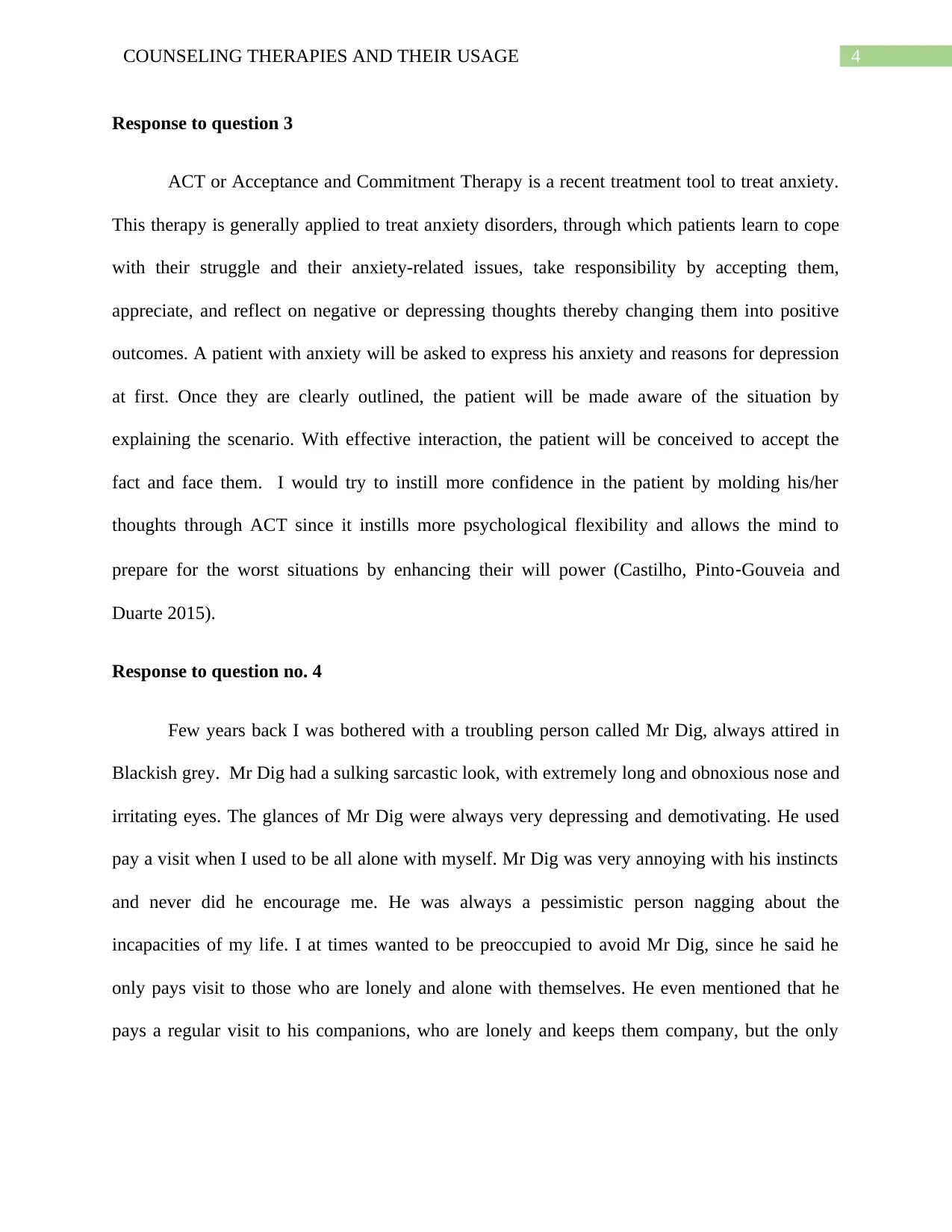
4COUNSELING THERAPIES AND THEIR USAGE
Response to question 3
ACT or Acceptance and Commitment Therapy is a recent treatment tool to treat anxiety.
This therapy is generally applied to treat anxiety disorders, through which patients learn to cope
with their struggle and their anxiety-related issues, take responsibility by accepting them,
appreciate, and reflect on negative or depressing thoughts thereby changing them into positive
outcomes. A patient with anxiety will be asked to express his anxiety and reasons for depression
at first. Once they are clearly outlined, the patient will be made aware of the situation by
explaining the scenario. With effective interaction, the patient will be conceived to accept the
fact and face them. I would try to instill more confidence in the patient by molding his/her
thoughts through ACT since it instills more psychological flexibility and allows the mind to
prepare for the worst situations by enhancing their will power (Castilho, Pinto‐Gouveia and
Duarte 2015).
Response to question no. 4
Few years back I was bothered with a troubling person called Mr Dig, always attired in
Blackish grey. Mr Dig had a sulking sarcastic look, with extremely long and obnoxious nose and
irritating eyes. The glances of Mr Dig were always very depressing and demotivating. He used
pay a visit when I used to be all alone with myself. Mr Dig was very annoying with his instincts
and never did he encourage me. He was always a pessimistic person nagging about the
incapacities of my life. I at times wanted to be preoccupied to avoid Mr Dig, since he said he
only pays visit to those who are lonely and alone with themselves. He even mentioned that he
pays a regular visit to his companions, who are lonely and keeps them company, but the only
Response to question 3
ACT or Acceptance and Commitment Therapy is a recent treatment tool to treat anxiety.
This therapy is generally applied to treat anxiety disorders, through which patients learn to cope
with their struggle and their anxiety-related issues, take responsibility by accepting them,
appreciate, and reflect on negative or depressing thoughts thereby changing them into positive
outcomes. A patient with anxiety will be asked to express his anxiety and reasons for depression
at first. Once they are clearly outlined, the patient will be made aware of the situation by
explaining the scenario. With effective interaction, the patient will be conceived to accept the
fact and face them. I would try to instill more confidence in the patient by molding his/her
thoughts through ACT since it instills more psychological flexibility and allows the mind to
prepare for the worst situations by enhancing their will power (Castilho, Pinto‐Gouveia and
Duarte 2015).
Response to question no. 4
Few years back I was bothered with a troubling person called Mr Dig, always attired in
Blackish grey. Mr Dig had a sulking sarcastic look, with extremely long and obnoxious nose and
irritating eyes. The glances of Mr Dig were always very depressing and demotivating. He used
pay a visit when I used to be all alone with myself. Mr Dig was very annoying with his instincts
and never did he encourage me. He was always a pessimistic person nagging about the
incapacities of my life. I at times wanted to be preoccupied to avoid Mr Dig, since he said he
only pays visit to those who are lonely and alone with themselves. He even mentioned that he
pays a regular visit to his companions, who are lonely and keeps them company, but the only
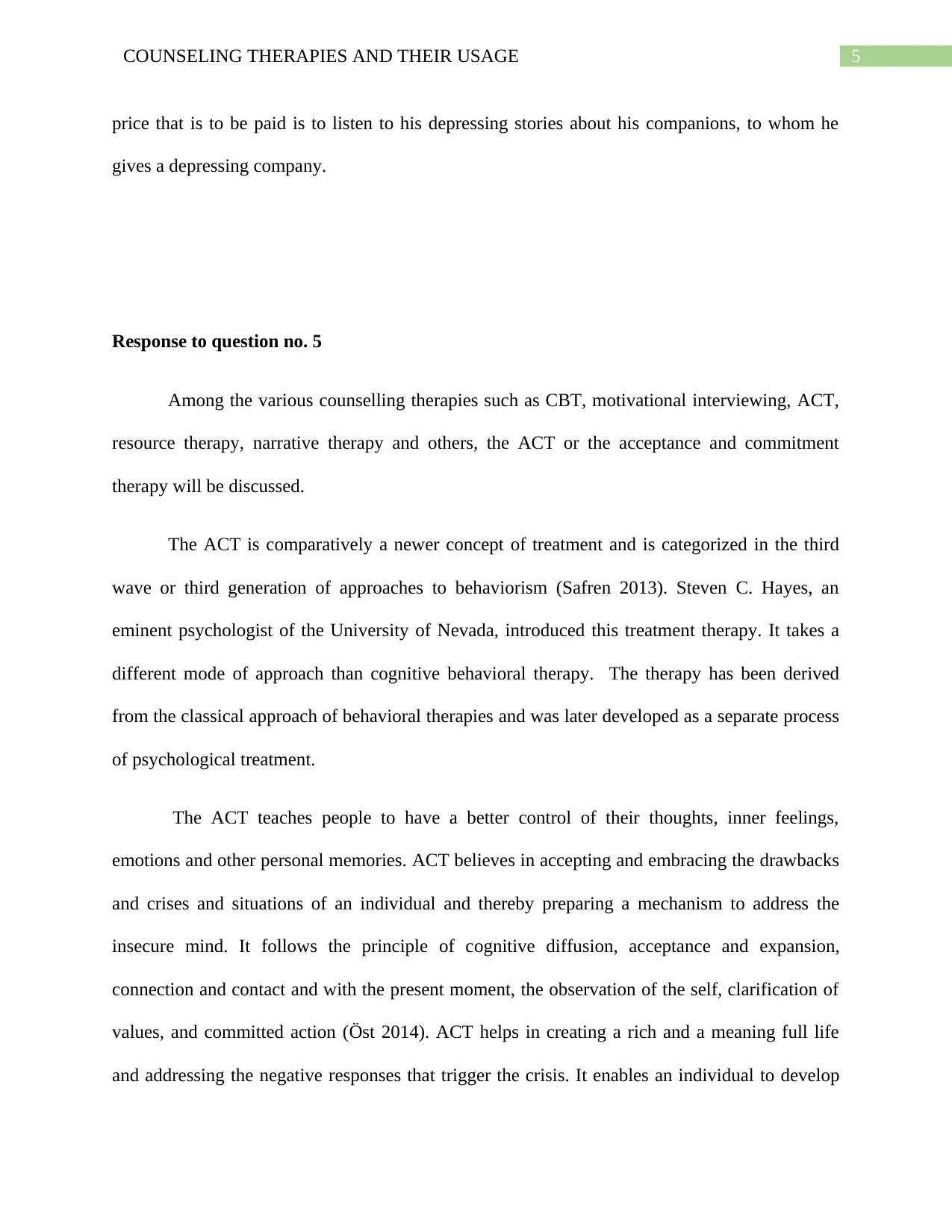
5COUNSELING THERAPIES AND THEIR USAGE
price that is to be paid is to listen to his depressing stories about his companions, to whom he
gives a depressing company.
Response to question no. 5
Among the various counselling therapies such as CBT, motivational interviewing, ACT,
resource therapy, narrative therapy and others, the ACT or the acceptance and commitment
therapy will be discussed.
The ACT is comparatively a newer concept of treatment and is categorized in the third
wave or third generation of approaches to behaviorism (Safren 2013). Steven C. Hayes, an
eminent psychologist of the University of Nevada, introduced this treatment therapy. It takes a
different mode of approach than cognitive behavioral therapy. The therapy has been derived
from the classical approach of behavioral therapies and was later developed as a separate process
of psychological treatment.
The ACT teaches people to have a better control of their thoughts, inner feelings,
emotions and other personal memories. ACT believes in accepting and embracing the drawbacks
and crises and situations of an individual and thereby preparing a mechanism to address the
insecure mind. It follows the principle of cognitive diffusion, acceptance and expansion,
connection and contact and with the present moment, the observation of the self, clarification of
values, and committed action (Öst 2014). ACT helps in creating a rich and a meaning full life
and addressing the negative responses that trigger the crisis. It enables an individual to develop
price that is to be paid is to listen to his depressing stories about his companions, to whom he
gives a depressing company.
Response to question no. 5
Among the various counselling therapies such as CBT, motivational interviewing, ACT,
resource therapy, narrative therapy and others, the ACT or the acceptance and commitment
therapy will be discussed.
The ACT is comparatively a newer concept of treatment and is categorized in the third
wave or third generation of approaches to behaviorism (Safren 2013). Steven C. Hayes, an
eminent psychologist of the University of Nevada, introduced this treatment therapy. It takes a
different mode of approach than cognitive behavioral therapy. The therapy has been derived
from the classical approach of behavioral therapies and was later developed as a separate process
of psychological treatment.
The ACT teaches people to have a better control of their thoughts, inner feelings,
emotions and other personal memories. ACT believes in accepting and embracing the drawbacks
and crises and situations of an individual and thereby preparing a mechanism to address the
insecure mind. It follows the principle of cognitive diffusion, acceptance and expansion,
connection and contact and with the present moment, the observation of the self, clarification of
values, and committed action (Öst 2014). ACT helps in creating a rich and a meaning full life
and addressing the negative responses that trigger the crisis. It enables an individual to develop
⊘ This is a preview!⊘
Do you want full access?
Subscribe today to unlock all pages.

Trusted by 1+ million students worldwide
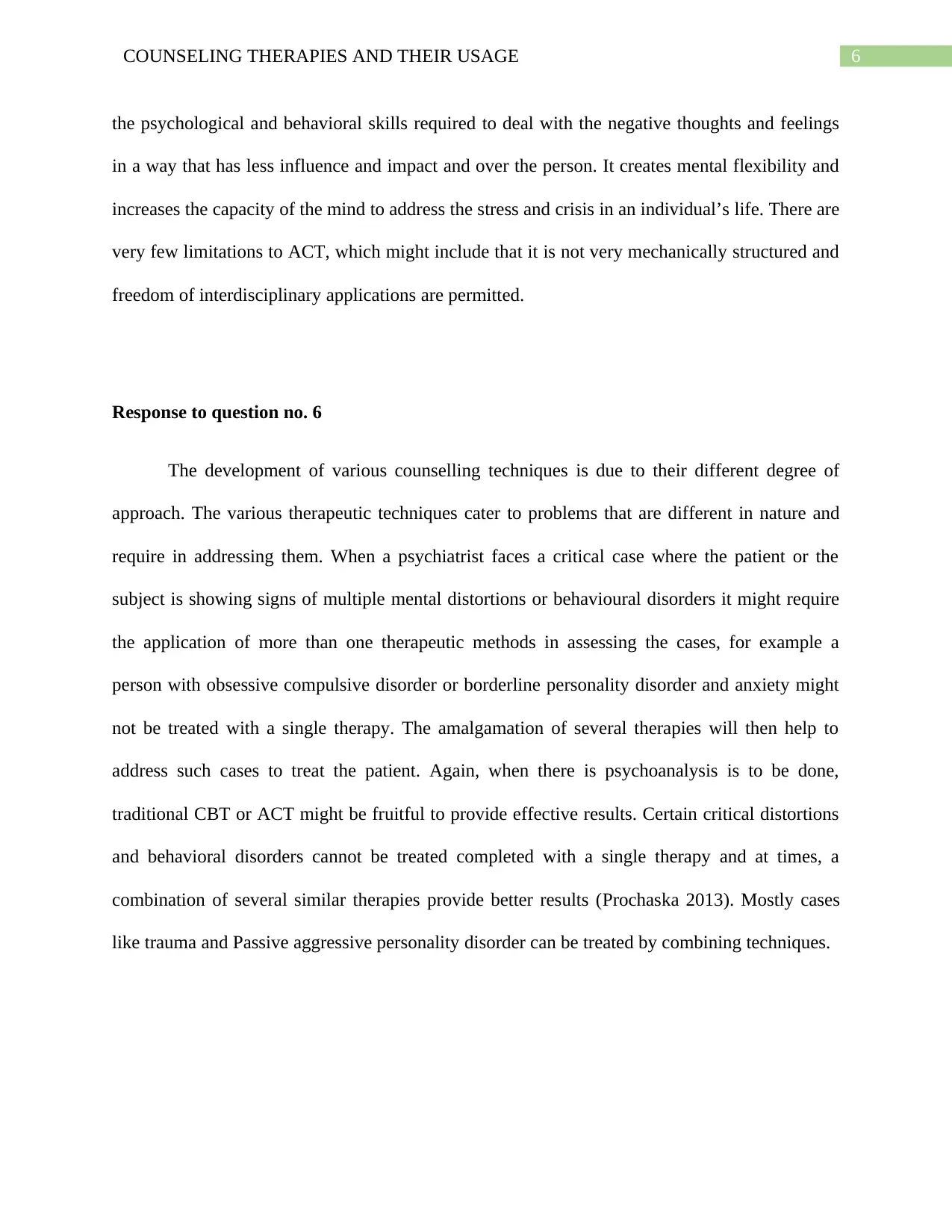
6COUNSELING THERAPIES AND THEIR USAGE
the psychological and behavioral skills required to deal with the negative thoughts and feelings
in a way that has less influence and impact and over the person. It creates mental flexibility and
increases the capacity of the mind to address the stress and crisis in an individual’s life. There are
very few limitations to ACT, which might include that it is not very mechanically structured and
freedom of interdisciplinary applications are permitted.
Response to question no. 6
The development of various counselling techniques is due to their different degree of
approach. The various therapeutic techniques cater to problems that are different in nature and
require in addressing them. When a psychiatrist faces a critical case where the patient or the
subject is showing signs of multiple mental distortions or behavioural disorders it might require
the application of more than one therapeutic methods in assessing the cases, for example a
person with obsessive compulsive disorder or borderline personality disorder and anxiety might
not be treated with a single therapy. The amalgamation of several therapies will then help to
address such cases to treat the patient. Again, when there is psychoanalysis is to be done,
traditional CBT or ACT might be fruitful to provide effective results. Certain critical distortions
and behavioral disorders cannot be treated completed with a single therapy and at times, a
combination of several similar therapies provide better results (Prochaska 2013). Mostly cases
like trauma and Passive aggressive personality disorder can be treated by combining techniques.
the psychological and behavioral skills required to deal with the negative thoughts and feelings
in a way that has less influence and impact and over the person. It creates mental flexibility and
increases the capacity of the mind to address the stress and crisis in an individual’s life. There are
very few limitations to ACT, which might include that it is not very mechanically structured and
freedom of interdisciplinary applications are permitted.
Response to question no. 6
The development of various counselling techniques is due to their different degree of
approach. The various therapeutic techniques cater to problems that are different in nature and
require in addressing them. When a psychiatrist faces a critical case where the patient or the
subject is showing signs of multiple mental distortions or behavioural disorders it might require
the application of more than one therapeutic methods in assessing the cases, for example a
person with obsessive compulsive disorder or borderline personality disorder and anxiety might
not be treated with a single therapy. The amalgamation of several therapies will then help to
address such cases to treat the patient. Again, when there is psychoanalysis is to be done,
traditional CBT or ACT might be fruitful to provide effective results. Certain critical distortions
and behavioral disorders cannot be treated completed with a single therapy and at times, a
combination of several similar therapies provide better results (Prochaska 2013). Mostly cases
like trauma and Passive aggressive personality disorder can be treated by combining techniques.
Paraphrase This Document
Need a fresh take? Get an instant paraphrase of this document with our AI Paraphraser
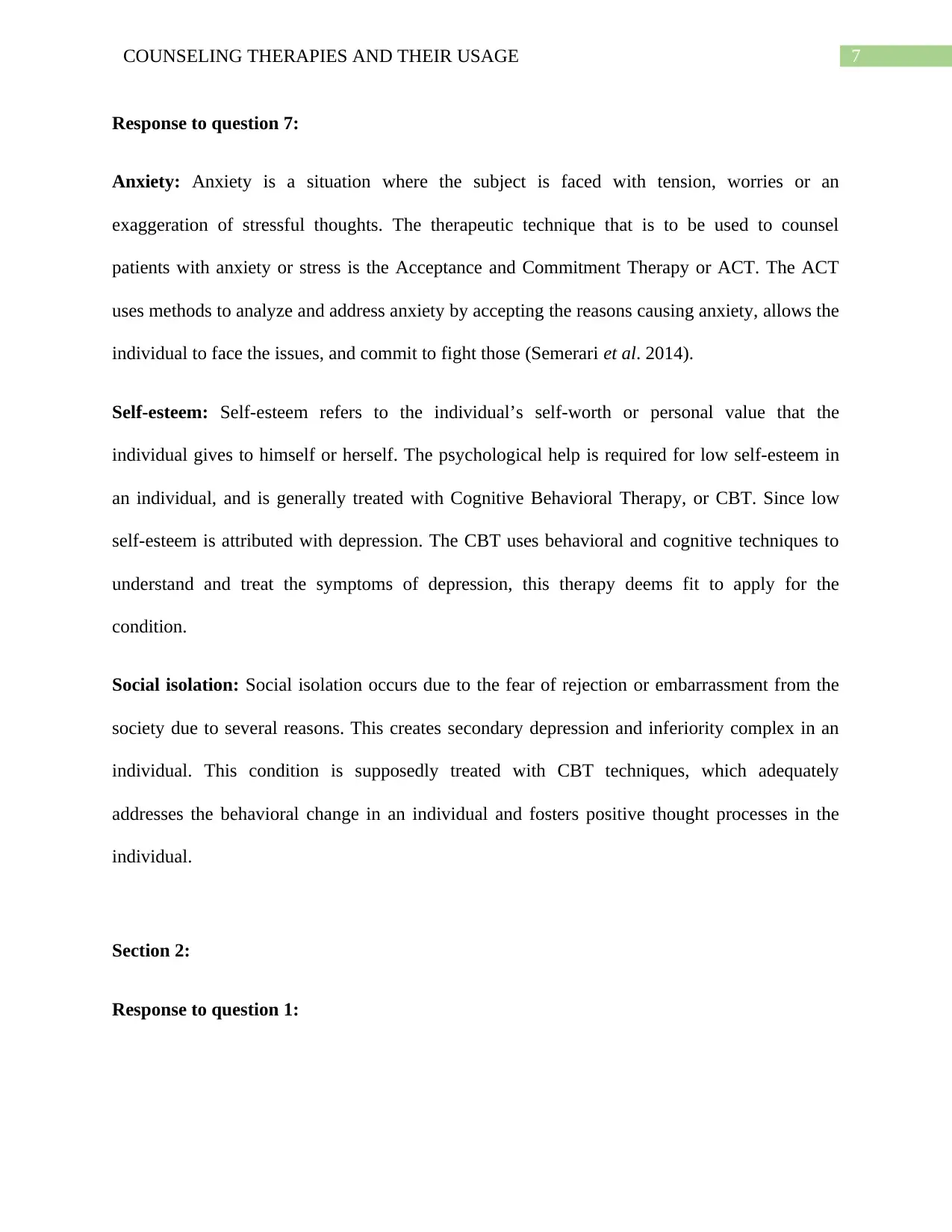
7COUNSELING THERAPIES AND THEIR USAGE
Response to question 7:
Anxiety: Anxiety is a situation where the subject is faced with tension, worries or an
exaggeration of stressful thoughts. The therapeutic technique that is to be used to counsel
patients with anxiety or stress is the Acceptance and Commitment Therapy or ACT. The ACT
uses methods to analyze and address anxiety by accepting the reasons causing anxiety, allows the
individual to face the issues, and commit to fight those (Semerari et al. 2014).
Self-esteem: Self-esteem refers to the individual’s self-worth or personal value that the
individual gives to himself or herself. The psychological help is required for low self-esteem in
an individual, and is generally treated with Cognitive Behavioral Therapy, or CBT. Since low
self-esteem is attributed with depression. The CBT uses behavioral and cognitive techniques to
understand and treat the symptoms of depression, this therapy deems fit to apply for the
condition.
Social isolation: Social isolation occurs due to the fear of rejection or embarrassment from the
society due to several reasons. This creates secondary depression and inferiority complex in an
individual. This condition is supposedly treated with CBT techniques, which adequately
addresses the behavioral change in an individual and fosters positive thought processes in the
individual.
Section 2:
Response to question 1:
Response to question 7:
Anxiety: Anxiety is a situation where the subject is faced with tension, worries or an
exaggeration of stressful thoughts. The therapeutic technique that is to be used to counsel
patients with anxiety or stress is the Acceptance and Commitment Therapy or ACT. The ACT
uses methods to analyze and address anxiety by accepting the reasons causing anxiety, allows the
individual to face the issues, and commit to fight those (Semerari et al. 2014).
Self-esteem: Self-esteem refers to the individual’s self-worth or personal value that the
individual gives to himself or herself. The psychological help is required for low self-esteem in
an individual, and is generally treated with Cognitive Behavioral Therapy, or CBT. Since low
self-esteem is attributed with depression. The CBT uses behavioral and cognitive techniques to
understand and treat the symptoms of depression, this therapy deems fit to apply for the
condition.
Social isolation: Social isolation occurs due to the fear of rejection or embarrassment from the
society due to several reasons. This creates secondary depression and inferiority complex in an
individual. This condition is supposedly treated with CBT techniques, which adequately
addresses the behavioral change in an individual and fosters positive thought processes in the
individual.
Section 2:
Response to question 1:
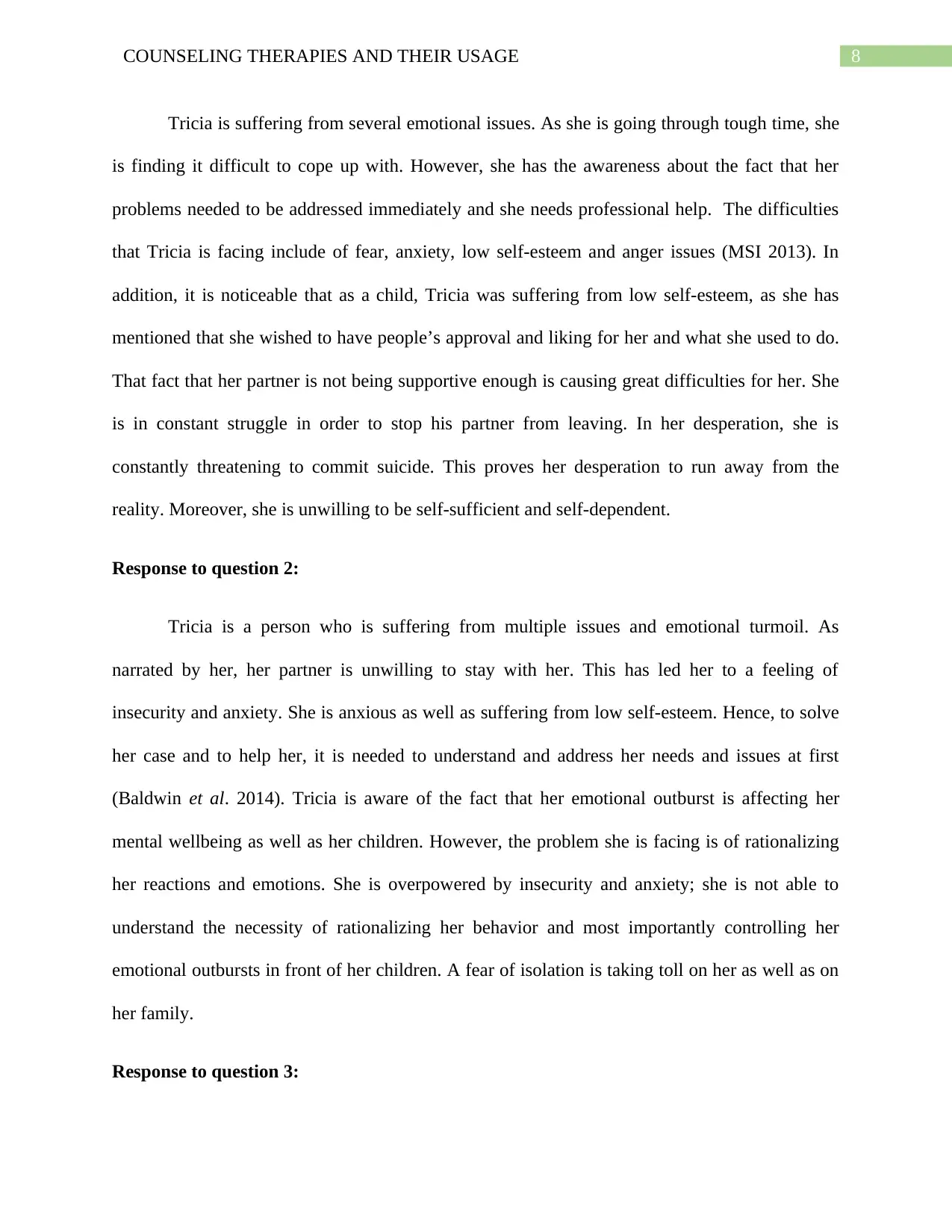
8COUNSELING THERAPIES AND THEIR USAGE
Tricia is suffering from several emotional issues. As she is going through tough time, she
is finding it difficult to cope up with. However, she has the awareness about the fact that her
problems needed to be addressed immediately and she needs professional help. The difficulties
that Tricia is facing include of fear, anxiety, low self-esteem and anger issues (MSI 2013). In
addition, it is noticeable that as a child, Tricia was suffering from low self-esteem, as she has
mentioned that she wished to have people’s approval and liking for her and what she used to do.
That fact that her partner is not being supportive enough is causing great difficulties for her. She
is in constant struggle in order to stop his partner from leaving. In her desperation, she is
constantly threatening to commit suicide. This proves her desperation to run away from the
reality. Moreover, she is unwilling to be self-sufficient and self-dependent.
Response to question 2:
Tricia is a person who is suffering from multiple issues and emotional turmoil. As
narrated by her, her partner is unwilling to stay with her. This has led her to a feeling of
insecurity and anxiety. She is anxious as well as suffering from low self-esteem. Hence, to solve
her case and to help her, it is needed to understand and address her needs and issues at first
(Baldwin et al. 2014). Tricia is aware of the fact that her emotional outburst is affecting her
mental wellbeing as well as her children. However, the problem she is facing is of rationalizing
her reactions and emotions. She is overpowered by insecurity and anxiety; she is not able to
understand the necessity of rationalizing her behavior and most importantly controlling her
emotional outbursts in front of her children. A fear of isolation is taking toll on her as well as on
her family.
Response to question 3:
Tricia is suffering from several emotional issues. As she is going through tough time, she
is finding it difficult to cope up with. However, she has the awareness about the fact that her
problems needed to be addressed immediately and she needs professional help. The difficulties
that Tricia is facing include of fear, anxiety, low self-esteem and anger issues (MSI 2013). In
addition, it is noticeable that as a child, Tricia was suffering from low self-esteem, as she has
mentioned that she wished to have people’s approval and liking for her and what she used to do.
That fact that her partner is not being supportive enough is causing great difficulties for her. She
is in constant struggle in order to stop his partner from leaving. In her desperation, she is
constantly threatening to commit suicide. This proves her desperation to run away from the
reality. Moreover, she is unwilling to be self-sufficient and self-dependent.
Response to question 2:
Tricia is a person who is suffering from multiple issues and emotional turmoil. As
narrated by her, her partner is unwilling to stay with her. This has led her to a feeling of
insecurity and anxiety. She is anxious as well as suffering from low self-esteem. Hence, to solve
her case and to help her, it is needed to understand and address her needs and issues at first
(Baldwin et al. 2014). Tricia is aware of the fact that her emotional outburst is affecting her
mental wellbeing as well as her children. However, the problem she is facing is of rationalizing
her reactions and emotions. She is overpowered by insecurity and anxiety; she is not able to
understand the necessity of rationalizing her behavior and most importantly controlling her
emotional outbursts in front of her children. A fear of isolation is taking toll on her as well as on
her family.
Response to question 3:
⊘ This is a preview!⊘
Do you want full access?
Subscribe today to unlock all pages.

Trusted by 1+ million students worldwide
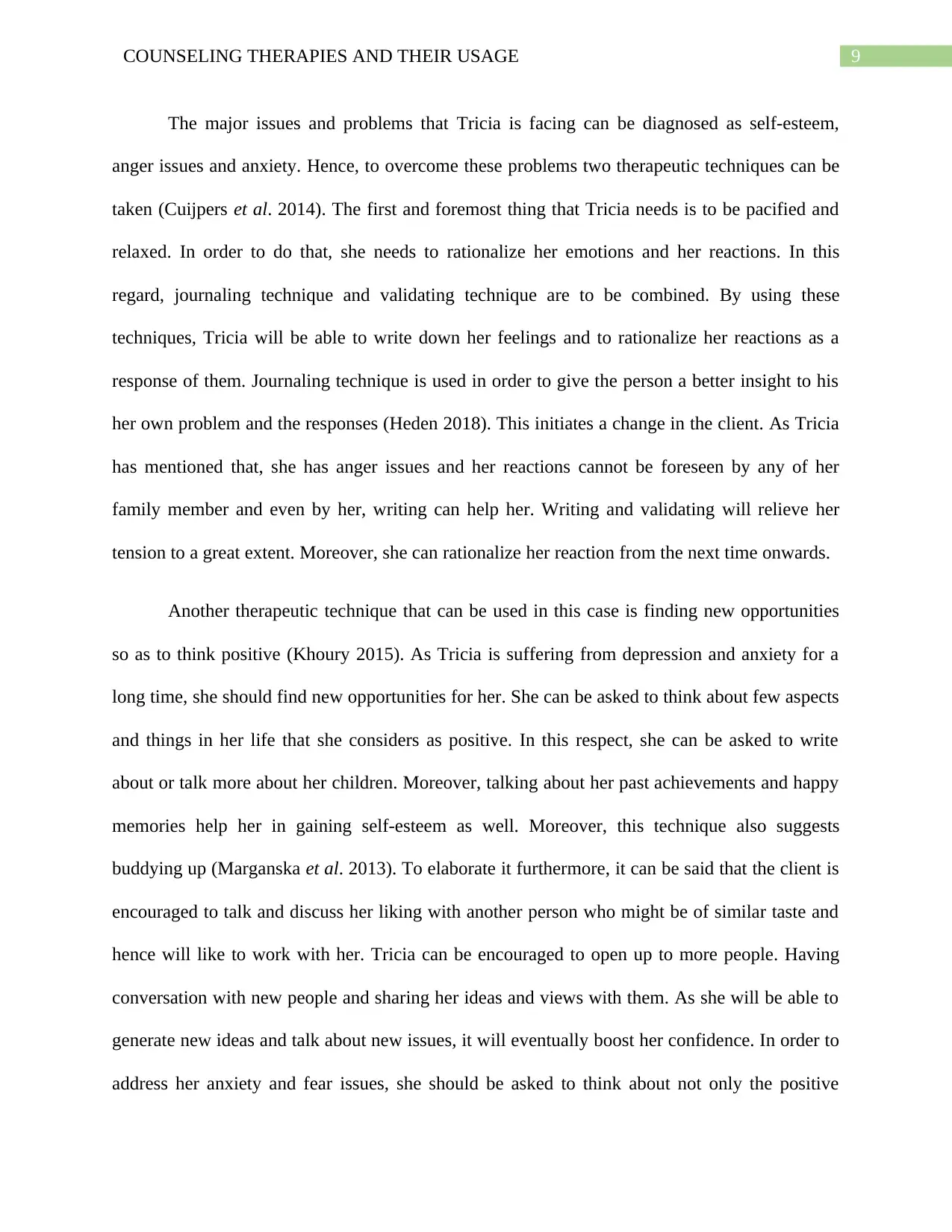
9COUNSELING THERAPIES AND THEIR USAGE
The major issues and problems that Tricia is facing can be diagnosed as self-esteem,
anger issues and anxiety. Hence, to overcome these problems two therapeutic techniques can be
taken (Cuijpers et al. 2014). The first and foremost thing that Tricia needs is to be pacified and
relaxed. In order to do that, she needs to rationalize her emotions and her reactions. In this
regard, journaling technique and validating technique are to be combined. By using these
techniques, Tricia will be able to write down her feelings and to rationalize her reactions as a
response of them. Journaling technique is used in order to give the person a better insight to his
her own problem and the responses (Heden 2018). This initiates a change in the client. As Tricia
has mentioned that, she has anger issues and her reactions cannot be foreseen by any of her
family member and even by her, writing can help her. Writing and validating will relieve her
tension to a great extent. Moreover, she can rationalize her reaction from the next time onwards.
Another therapeutic technique that can be used in this case is finding new opportunities
so as to think positive (Khoury 2015). As Tricia is suffering from depression and anxiety for a
long time, she should find new opportunities for her. She can be asked to think about few aspects
and things in her life that she considers as positive. In this respect, she can be asked to write
about or talk more about her children. Moreover, talking about her past achievements and happy
memories help her in gaining self-esteem as well. Moreover, this technique also suggests
buddying up (Marganska et al. 2013). To elaborate it furthermore, it can be said that the client is
encouraged to talk and discuss her liking with another person who might be of similar taste and
hence will like to work with her. Tricia can be encouraged to open up to more people. Having
conversation with new people and sharing her ideas and views with them. As she will be able to
generate new ideas and talk about new issues, it will eventually boost her confidence. In order to
address her anxiety and fear issues, she should be asked to think about not only the positive
The major issues and problems that Tricia is facing can be diagnosed as self-esteem,
anger issues and anxiety. Hence, to overcome these problems two therapeutic techniques can be
taken (Cuijpers et al. 2014). The first and foremost thing that Tricia needs is to be pacified and
relaxed. In order to do that, she needs to rationalize her emotions and her reactions. In this
regard, journaling technique and validating technique are to be combined. By using these
techniques, Tricia will be able to write down her feelings and to rationalize her reactions as a
response of them. Journaling technique is used in order to give the person a better insight to his
her own problem and the responses (Heden 2018). This initiates a change in the client. As Tricia
has mentioned that, she has anger issues and her reactions cannot be foreseen by any of her
family member and even by her, writing can help her. Writing and validating will relieve her
tension to a great extent. Moreover, she can rationalize her reaction from the next time onwards.
Another therapeutic technique that can be used in this case is finding new opportunities
so as to think positive (Khoury 2015). As Tricia is suffering from depression and anxiety for a
long time, she should find new opportunities for her. She can be asked to think about few aspects
and things in her life that she considers as positive. In this respect, she can be asked to write
about or talk more about her children. Moreover, talking about her past achievements and happy
memories help her in gaining self-esteem as well. Moreover, this technique also suggests
buddying up (Marganska et al. 2013). To elaborate it furthermore, it can be said that the client is
encouraged to talk and discuss her liking with another person who might be of similar taste and
hence will like to work with her. Tricia can be encouraged to open up to more people. Having
conversation with new people and sharing her ideas and views with them. As she will be able to
generate new ideas and talk about new issues, it will eventually boost her confidence. In order to
address her anxiety and fear issues, she should be asked to think about not only the positive
Paraphrase This Document
Need a fresh take? Get an instant paraphrase of this document with our AI Paraphraser
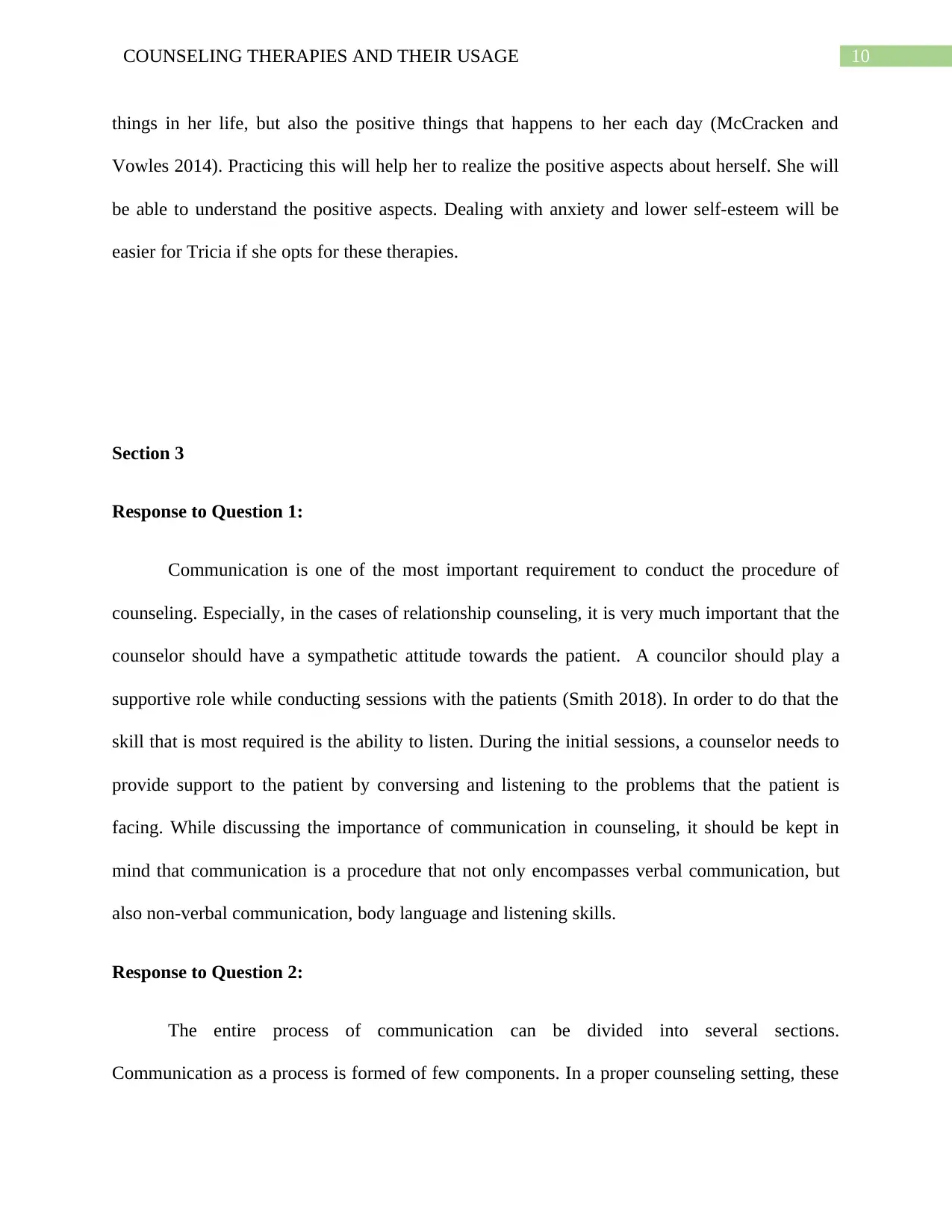
10COUNSELING THERAPIES AND THEIR USAGE
things in her life, but also the positive things that happens to her each day (McCracken and
Vowles 2014). Practicing this will help her to realize the positive aspects about herself. She will
be able to understand the positive aspects. Dealing with anxiety and lower self-esteem will be
easier for Tricia if she opts for these therapies.
Section 3
Response to Question 1:
Communication is one of the most important requirement to conduct the procedure of
counseling. Especially, in the cases of relationship counseling, it is very much important that the
counselor should have a sympathetic attitude towards the patient. A councilor should play a
supportive role while conducting sessions with the patients (Smith 2018). In order to do that the
skill that is most required is the ability to listen. During the initial sessions, a counselor needs to
provide support to the patient by conversing and listening to the problems that the patient is
facing. While discussing the importance of communication in counseling, it should be kept in
mind that communication is a procedure that not only encompasses verbal communication, but
also non-verbal communication, body language and listening skills.
Response to Question 2:
The entire process of communication can be divided into several sections.
Communication as a process is formed of few components. In a proper counseling setting, these
things in her life, but also the positive things that happens to her each day (McCracken and
Vowles 2014). Practicing this will help her to realize the positive aspects about herself. She will
be able to understand the positive aspects. Dealing with anxiety and lower self-esteem will be
easier for Tricia if she opts for these therapies.
Section 3
Response to Question 1:
Communication is one of the most important requirement to conduct the procedure of
counseling. Especially, in the cases of relationship counseling, it is very much important that the
counselor should have a sympathetic attitude towards the patient. A councilor should play a
supportive role while conducting sessions with the patients (Smith 2018). In order to do that the
skill that is most required is the ability to listen. During the initial sessions, a counselor needs to
provide support to the patient by conversing and listening to the problems that the patient is
facing. While discussing the importance of communication in counseling, it should be kept in
mind that communication is a procedure that not only encompasses verbal communication, but
also non-verbal communication, body language and listening skills.
Response to Question 2:
The entire process of communication can be divided into several sections.
Communication as a process is formed of few components. In a proper counseling setting, these
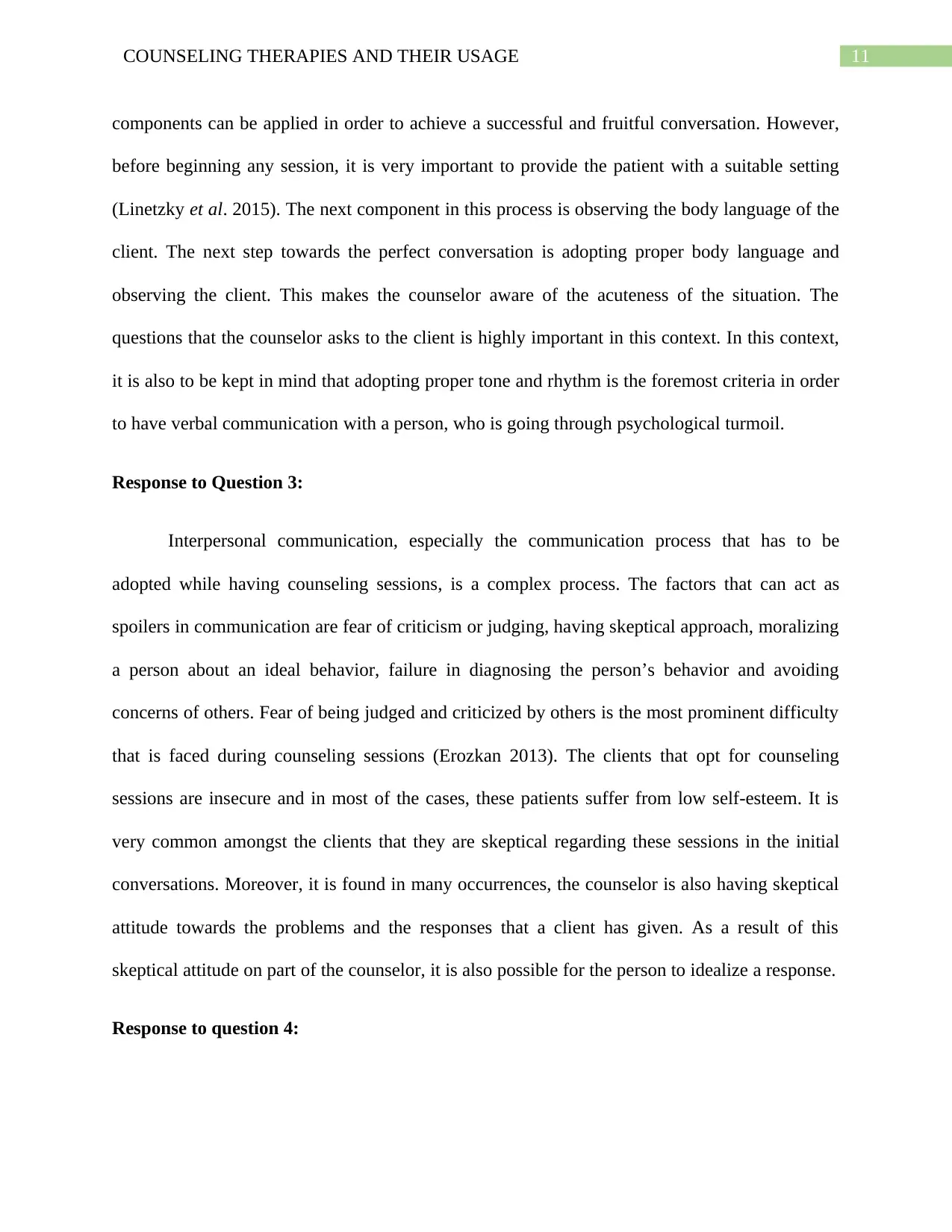
11COUNSELING THERAPIES AND THEIR USAGE
components can be applied in order to achieve a successful and fruitful conversation. However,
before beginning any session, it is very important to provide the patient with a suitable setting
(Linetzky et al. 2015). The next component in this process is observing the body language of the
client. The next step towards the perfect conversation is adopting proper body language and
observing the client. This makes the counselor aware of the acuteness of the situation. The
questions that the counselor asks to the client is highly important in this context. In this context,
it is also to be kept in mind that adopting proper tone and rhythm is the foremost criteria in order
to have verbal communication with a person, who is going through psychological turmoil.
Response to Question 3:
Interpersonal communication, especially the communication process that has to be
adopted while having counseling sessions, is a complex process. The factors that can act as
spoilers in communication are fear of criticism or judging, having skeptical approach, moralizing
a person about an ideal behavior, failure in diagnosing the person’s behavior and avoiding
concerns of others. Fear of being judged and criticized by others is the most prominent difficulty
that is faced during counseling sessions (Erozkan 2013). The clients that opt for counseling
sessions are insecure and in most of the cases, these patients suffer from low self-esteem. It is
very common amongst the clients that they are skeptical regarding these sessions in the initial
conversations. Moreover, it is found in many occurrences, the counselor is also having skeptical
attitude towards the problems and the responses that a client has given. As a result of this
skeptical attitude on part of the counselor, it is also possible for the person to idealize a response.
Response to question 4:
components can be applied in order to achieve a successful and fruitful conversation. However,
before beginning any session, it is very important to provide the patient with a suitable setting
(Linetzky et al. 2015). The next component in this process is observing the body language of the
client. The next step towards the perfect conversation is adopting proper body language and
observing the client. This makes the counselor aware of the acuteness of the situation. The
questions that the counselor asks to the client is highly important in this context. In this context,
it is also to be kept in mind that adopting proper tone and rhythm is the foremost criteria in order
to have verbal communication with a person, who is going through psychological turmoil.
Response to Question 3:
Interpersonal communication, especially the communication process that has to be
adopted while having counseling sessions, is a complex process. The factors that can act as
spoilers in communication are fear of criticism or judging, having skeptical approach, moralizing
a person about an ideal behavior, failure in diagnosing the person’s behavior and avoiding
concerns of others. Fear of being judged and criticized by others is the most prominent difficulty
that is faced during counseling sessions (Erozkan 2013). The clients that opt for counseling
sessions are insecure and in most of the cases, these patients suffer from low self-esteem. It is
very common amongst the clients that they are skeptical regarding these sessions in the initial
conversations. Moreover, it is found in many occurrences, the counselor is also having skeptical
attitude towards the problems and the responses that a client has given. As a result of this
skeptical attitude on part of the counselor, it is also possible for the person to idealize a response.
Response to question 4:
⊘ This is a preview!⊘
Do you want full access?
Subscribe today to unlock all pages.

Trusted by 1+ million students worldwide
1 out of 21
Your All-in-One AI-Powered Toolkit for Academic Success.
+13062052269
info@desklib.com
Available 24*7 on WhatsApp / Email
![[object Object]](/_next/static/media/star-bottom.7253800d.svg)
Unlock your academic potential
Copyright © 2020–2025 A2Z Services. All Rights Reserved. Developed and managed by ZUCOL.